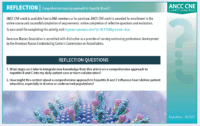What nurses need to know about long COVID


Lost in the crush of headlines focused on many other important news topics is the persistence and recent resurgence of COVID-19. New data, as of August 2024, warn that a COVID-19 wave has surged throughout the United States and could increase as autumn arrives and people move indoors. The more we learn about the virus, the more we’re learning about long COVID or post-COVID-19 syndrome.
New data published in the July 2, 2024, issue of the Journal of the American Medical Association reveal that as of early 2023, at least 7% of U.S. adults have experienced long COVID symptoms. The data also indicate that females are more likely to have long COVID than males.
This topic is very personal to me. My husband was diagnosed (using genetic and blood testing) with long COVID in 2022 after contracting COVID-19 three times, despite recommended vaccinations and boosters. He now sees a long COVID specialist physician several times a year.
So, what should nurses know?
Most people experience COVID-19 symptoms and recover within 5 to 7 days. However, when that initial infection morphs into long COVID, a kaleidoscope of symptoms can continue for 3 to 6 months. Patients exhibit various symptoms, such as persistent fatigue, that may become permanent as a result of how the virus initially damaged the body.
Long COVID is diagnosed largely by the patient’s history. A single severe COVID-19 episode or multiple milder episodes seem to serve as good predictors for contracting long COVID. New genetic tests can predict susceptibility or identify those most at risk. Research to define long COVID and identify associated symptoms continues due to the number of potentially affected organ systems.
As we learn more about COVID-19 and how the virus damages the body, plus the discovery of long COVID as a new and persistent danger, you may have heard about special clinics focused solely on treating these conditions. Various physician specialties have broadened their clinical offerings to reflect knowledge and competency in the diagnosis and treatment of long COVID. Treatment varies and can include prescription medications, nutritional supplements, and physical therapy. The more we learn about the prolonged course of these conditions, the better we’ll be able to provide more effective and targeted therapies.
With this increasing prevalence, nurses need to know what to do if they develop what they believe are long COVID symptoms, and where to seek treatment for faster and more complete recovery.
Nurses also need to understand how long COVID can influence patient assessments and care. Research findings recommend that physicians and nurses add questions about COVID-19 and long COVID to all patient histories and physicals. Know that long COVID can mimic the symptoms of other diseases and disorders, which can confuse the development of an accurate and complete diagnosis. When you begin treating patients for their initial complaint, you’ll need to consider how long COVID symptoms can mitigate your treatment plan. Treatment must be informed by the latest research and experimental regimens.
Nurses provide most of the care and support throughout the entire continuum of the patient experience. Expanding your assessments, plans of care, and selection of treatment tools can help address the frequently hidden needs of patients with long COVID.
It looks like COVID-19 variants will be with us for a long time, so let’s stay informed and get ready to do what we do best!


Lillee Gelinas, DNP, RN, CPPS, FAAN
Editor-in-Chief
American Nurse Journal. 2024; 19(10). Doi: 10.51256/ANJ102404


















